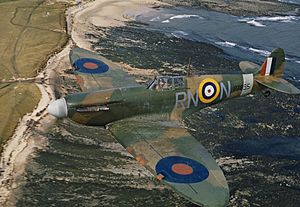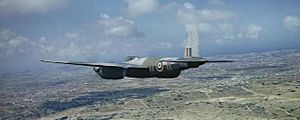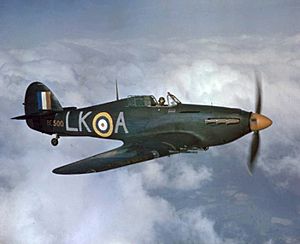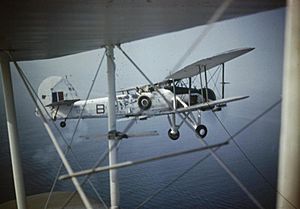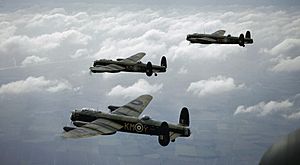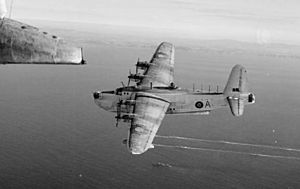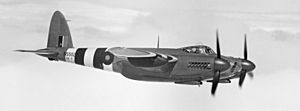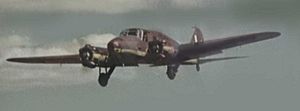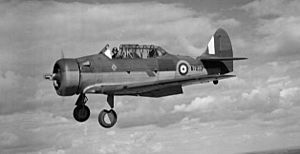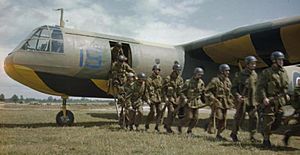List of aircraft of the United Kingdom in World War II facts for kids
Here is a list of the amazing aircraft used by the British Royal Air Force (RAF), Royal Navy's Fleet Air Arm (FAA), Army Air Corps (AAC), and British Overseas Airways Corporation (BOAC) during World War II. These planes helped win the war in many different ways!
Contents
- Fighters and Fighter-Bombers: Sky Protectors
- Bombers: Striking from the Sky
- Maritime Patrol and Coastal Reconnaissance: Eyes on the Sea
- Photo Reconnaissance: Taking Pictures from Above
- Trainers and Target Tugs: Learning to Fly
- Transport and Communications: Moving People and Supplies
- Gliders: Silent Wings
- Images for kids
- See also
Fighters and Fighter-Bombers: Sky Protectors
These planes were built for speed and combat. They fought enemy aircraft and sometimes attacked targets on the ground.
- Bell Airacobra (RAF)
- Blackburn Roc (FAA) - a naval fighter with a gun turret, retired from combat by 1941.
- Blackburn Skua (FAA) - a naval fighter and dive bomber, retired from combat by 1941.
- Boulton Paul Defiant (RAF) - a fighter with a gun turret, used as a night fighter until 1942-1943.
- Brewster Buffalo (RAF)
- Bristol Beaufighter (RAF) - a powerful strike fighter.
- Bristol Blenheim (RAF) - used as a long-range fighter and night fighter.
- Curtiss Mohawk (RAF)
- Curtiss Kittyhawk and Tomahawk (RAF)
- de Havilland Mosquito (RAF) - a very fast night fighter and fighter-bomber.
- de Havilland Vampire (RAF) - an early jet fighter prototype.
- Douglas Havoc (RAF) - used as a night fighter.
- Fairey Fulmar (FAA) - a fleet fighter for the navy.
- Fairey Firefly (FAA) - another fleet fighter.
- Gloster Gladiator (RAF, FAA)
- Gloster Sea Gladiator (FAA)
- Gloster Meteor (RAF) - one of the first jet fighters.
- Grumman Martlet/Wildcat (FAA)
- Grumman Hellcat (FAA)
- Hawker Hurricane (RAF, FAA) - a key fighter in the Battle of Britain.
- Hawker Sea Hurricane (FAA)
- Hawker Tempest (RAF)
- Hawker Typhoon (RAF)
- North American Mustang (RAF) - a very famous and effective fighter.
- Republic Thunderbolt (RAF)
- Supermarine Spitfire (RAF & FAA) - perhaps the most famous British fighter.
- Supermarine Seafire (FAA) - a naval version of the Spitfire.
- Vought Corsair (FAA)
- Westland Whirlwind (RAF) - a twin-engine fighter.
- Westland Welkin (RAF) - a high-altitude fighter.
Bombers: Striking from the Sky
These aircraft were designed to carry bombs and attack enemy targets on the ground or at sea.
Torpedo Bombers, Dive Bombers, and Army Cooperation
These planes had special jobs. Torpedo bombers attacked ships, dive bombers aimed precisely at targets, and army cooperation planes helped ground troops.
- Avro Rota (RAF) - an autogyro used for army cooperation.
- Blackburn Skua (FAA) - also used as a naval dive bomber.
- Fairey Albacore (RAF, FAA) - a torpedo and dive bomber.
- Fairey Barracuda (FAA) - another torpedo and dive bomber.
- Fairey Swordfish (FAA) - a famous biplane torpedo bomber.
- Grumman Tarpon/Avenger (FAA) - a powerful torpedo bomber.
- Hawker Audax (RAF) - a biplane used for army cooperation.
- Hawker Hardy (RAF) - a general-purpose biplane.
- Hawker Hector (RAF) - another biplane for army cooperation.
- Hawker Hind (RAF) - a light bomber.
- North American Mustang (RAF) - also used for scouting and ground attacks.
- Vickers Vildebeest (RAF) - a torpedo bomber, retired by 1942.
- Westland Lysander (RAF) - used for army cooperation, often for secret missions.
- Westland Wapiti (RAF) - a general-purpose biplane used in India until 1940.
Level Bombers: Bombing from High Altitudes
These large planes flew at high altitudes to drop bombs over enemy areas.
- Armstrong Whitworth Albemarle (RAF)
- Armstrong Whitworth Whitley (RAF)
- Avro Manchester (RAF)
- Avro Lancaster (RAF) - one of the most famous and effective heavy bombers.
- Avro Lincoln (RAF)
- Boeing Fortress (RAF) - a well-known American bomber.
- Boulton Paul Overstrand (RAF) - withdrawn from service in late 1939.
- Bristol Beaufort (RAF, FAA)
- Bristol Blenheim/Bisley (RAF)
- Bristol Bombay (RAF) - also used as a bomber-transport.
- Douglas Boston (RAF)
- Fairey Battle (RAF)
- Fairey Gordon (RAF)
- Handley Page Halifax (RAF) - another important heavy bomber.
- Handley Page Hampden/Hereford (RAF)
- Lockheed Hudson (RAF)
- Lockheed Ventura (RAF)
- Martin Maryland (RAF, FAA)
- Martin Marauder (RAF)
- Martin Baltimore (RAF, FAA)
- North American Mitchell (RAF, FAA)
- Short Stirling (RAF) - an early British heavy bomber.
- Vickers Valentia (RAF) - also used as a bomber-transport.
- Vickers Vincent (RAF) - a general-purpose plane.
- Vickers Warwick (RAF) - mostly used for sea patrols and rescue.
- Vickers Wellesley (RAF)
- Vickers Wellington (RAF) - a very versatile bomber.
Maritime Patrol and Coastal Reconnaissance: Eyes on the Sea
These planes patrolled the seas, looking for enemy ships and submarines, and helped rescue people from the water.
- Armstrong Whitworth Whitley (RAF)
- Avro Anson (RAF, FAA)
- Boeing Fortress (RAF)
- Blackburn Botha (RAF)
- Bristol Beaufort (RAF, FAA)
- Consolidated Catalina (RAF) - a famous flying boat.
- Consolidated Liberator (RAF) - important for long-range patrols.
- Fairey Seal (RAF, FAA) - outdated by 1943.
- Fairey Seafox (FAA) - a floatplane.
- Fokker T.VIII (RAF) - an ex-Dutch floatplane used in 1940.
- Handley Page Hampden (RAF)
- Lockheed Hudson (RAF)
- Lockheed Ventura (RAF)
- Martin Maryland (RAF)
- Saro London (RAF) - retired 1941.
- Saro Lerwick (RAF) - retired 1942.
- Short Empire (RAF) - two aircraft used.
- Short Seaford (RAF) - used after VE Day in 1945.
- Short Singapore (RAF) - retired 1941.
- Short Sunderland (RAF) - a large and powerful flying boat.
- Supermarine Walrus (FAA, RAF) - used for air-sea rescue.
- Supermarine Sea Otter (RAF and FAA) - also for air-sea rescue.
- Supermarine Stranraer (RAF) - retired 1942.
- Vickers Warwick (RAF)
- Vickers Wellington (RAF)
- Vought Kingfisher (FAA)
- Westland Lysander (RAF)
Photo Reconnaissance: Taking Pictures from Above
These planes were equipped with cameras to take pictures of enemy positions, helping military planners.
- Bristol Blenheim (RAF)
- de Havilland Mosquito (RAF) - very fast and hard to catch.
- Lockheed Hudson (RAF)
- North American Mustang (RAF)
- Supermarine Spitfire (RAF) - special versions were used for photo missions.
Trainers and Target Tugs: Learning to Fly
These aircraft were essential for training new pilots and aircrews, and for towing targets for gunnery practice.
- Airspeed Oxford (RAF) - a bomber trainer.
- Avro 626 (RAF)
- Avro Anson (RAF, FAA) - used for training multi-engine pilots and bomber crews.
- Avro Tutor (RAF, FAA)
- Blackburn B-2 (RAF) - mostly used by civilian training schools until 1942.
- Blackburn Botha (RAF) - used as a target tug, retired 1944.
- Blackburn Shark (FAA) - used for training after its combat role ended.
- Boulton Paul Defiant (RAF) - used for gunnery training from 1942 to 1945.
- Boulton Paul Overstrand (RAF) - an older bomber used for gunnery training until 1941.
- Cierva C.30 (RAF) - used for army cooperation training.
- Curtiss Cleveland (RAF) - used for ground training.
- de Havilland Tiger Moth (RAF, FAA) - a primary trainer for many pilots.
- de Havilland Dominie (RAF) - used for radio training.
- de Havilland Don (RAF) - used for ground training.
- Fairey III.F (FAA) - an older bomber used as a target tug until 1941.
- Fairey Gordon (RAF) - an older bomber used as a trainer and target tug.
- Fairey Seal (RAF) - an older bomber used as a trainer and target tug until 1942.
- General Aircraft Cygnet (RAF) - a trainer with a special landing gear.
- General Aircraft Owlet (RAF) - another trainer with a special landing gear.
- Handley Page Heyford (RAF) - an older bomber used as a trainer until 1941.
- Hawker Demon (RAF) - an older fighter used as a trainer.
- Hawker Hart (RAF) - an older bomber used as a trainer and target tug.
- Hawker Henley (RAF) - used as a target tug.
- Hawker Osprey (FAA) - an older fighter used as a trainer.
- Miles Magister (RAF) - a primary trainer.
- Miles Martinet (RAF)
- Miles Master (RAF) - used as a target tug.
- North American Harvard (RAF, FAA) - an advanced pilot trainer.
- Percival Proctor (RAF, FAA) - used for radio training.
- Sikorsky Hoverfly (RAF) - an early helicopter.
- Vickers Wellington (RAF) - used as a bomber trainer.
- Westland Lysander (RAF) - used as a target tug.
- Westland Wallace (RAF) - an older bomber used as a target tug until 1943.
Transport and Communications: Moving People and Supplies
These planes were the workhorses of the air, carrying troops, supplies, and important messages.
- Airspeed Envoy (RAF)
- Airspeed Courier (RAF)
- Armstrong Whitworth Albemarle (RAF)
- Armstrong Whitworth Ensign (BOAC)
- Armstrong Whitworth Whitley (RAF)
- Avro Lancastrian (RAF, BOAC)
- Avro York (RAF)
- Beechcraft Expeditor (RAF, FAA)
- Boeing Clipper (BOAC)
- Bristol Bombay (RAF)
- Bristol Buckingham (RAF)
- Consolidated PB2Y Coronado (RAF)
- Consolidated Liberator (RAF)
- de Havilland Albatross (Imperial Airways, BOAC, RAF)
- de Havilland Express (RAF, FAA)
- de Havilland Dragon Rapide (RAF, FAA)
- de Havilland Dragonfly (RAF)
- de Havilland Flamingo (RAF, FAA, BOAC)
- de Havilland Hornet Moth (RAF)
- de Havilland Leopard Moth (RAF)
- de Havilland Mosquito (BOAC)
- de Havilland Moth Minor (RAF, FAA)
- de Havilland Puss Moth (RAF)
- Douglas Dakota (RAF, BOAC) - a very common and important transport plane.
- Douglas Skymaster (RAF)
- Fairchild Argus (RAF)
- Foster Wikner Warferry (RAF)
- Grumman G-21 Goose (RAF, FAA)
- Grumman Gosling (RAF, FAA)
- Handley Page Halifax (RAF) - also used as a transport.
- Handley Page H.P.42 (RAF)
- Handley Page H.P.54 Harrow (RAF)
- Hawker Hardy (RAF)
- Heston Phoenix (RAF)
- Percival Petrel (RAF)
- Percival Proctor (RAF)
- Percival Vega Gull (RAF)
- Lockheed Lodestar (RAF, BOAC)
- Messerschmitt Aldon (RAF)
- Miles Mentor (RAF)
- Miles Mercury (RAF)
- Miles Messenger (RAF)
- Short C-Class Empire (RAF, BOAC)
- Short Hythe (BOAC)
- Short S.26 G-Class Empire (RAF, BOAC)
- Short Stirling (RAF) - also used as a transport.
- Short Scylla (BOAC)
- Sikorsky Hoverfly (RAF)
- Stinson Reliant (RAF, FAA)
- Stinson L-5 Sentinel (RAF)
- Stinson L-1 Vigilant (RAF, FAA)
- Taylorcraft Auster (RAF)
- Vickers Type 264 Valentia (RAF)
- Vickers Warwick (RAF)
- Westland Lysander (RAF)
Gliders: Silent Wings
Gliders were aircraft with no engines, pulled by other planes. They were used to secretly land troops and equipment during special operations.
- Airspeed Horsa (RAF, Army Air Corps) - a very important troop glider.
- General Aircraft Hamilcar (RAF, Army Air Corps) - a large glider for carrying vehicles.
- General Aircraft Hotspur (RAF, Army Air Corps) - used for training glider pilots.
- Slingsby Hengist (RAF)
- Waco Hadrian (RAF, Army Air Corps) - an American glider used by British forces.
Images for kids
See also
- List of aircraft of the Royal Air Force
- List of aircraft of the Fleet Air Arm
- List of Fleet Air Arm aircraft in World War II
- List of aircraft of World War II


